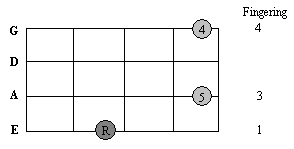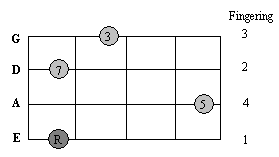Level: beginner
No part of this lesson may be copied, reproduced, or distributed in any form without consent of the author. Copyright © Doug Ross, all rights reserved.
Don’t be intimidated by all of the frets on the bass neck! This instrument is actually laid out very logically, and I’d like to show you how easy it is to figure out the name of any note on your fingerboard.
The musical “alphabet” uses only the first seven letters A-G, and a few “in-between” notes, which we call accidentals. Here’s what you need to remember: There is always an accidental in between each two letters, except between E-F and between B-C.
In other words, the note D is two frets up from C. Then E is two frets up from D. But F is only going to be one fret up from E (no accidental in between them). Then G will be two frets up from F, and so on.
This is true everywhere on the fingerboard, all of the time. So if you know the names of the starting points, the open strings, then you should be able to work out all of the other note names up from there.
By the way, the accidentals can either be thought of as raised notes (“sharps” symbolized by #), or as lowered notes (“flats” symbolized by b). So here are the notes on the first seven frets of the E string:

Notice that there is no accidental between the open E and F on the first fret. I’ve written all of the accidentals in the above fingerboard diagram as sharps. Of course, I could also think of them as flats:

Whether to indicate sharps or flats depends on context, mainly determined by the key of the song. For now, learn all accidentals by both names. Let’s move on to the A string:



The same principle applies to learning notes on the low B or high C strings for a five or six string bass. It will take awhile for all these notes to become thoroughly familiar, but now you know how to figure them out. As I mentioned before, all you need to remember are the open string names, and the simple rule: There is always an accidental in between each two letters, except between E-F and between B-C.



